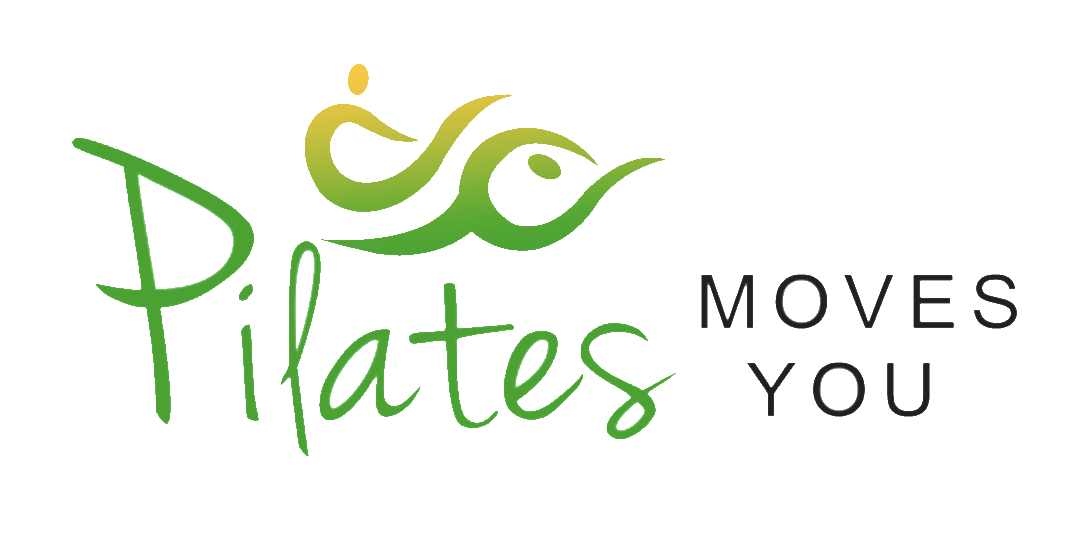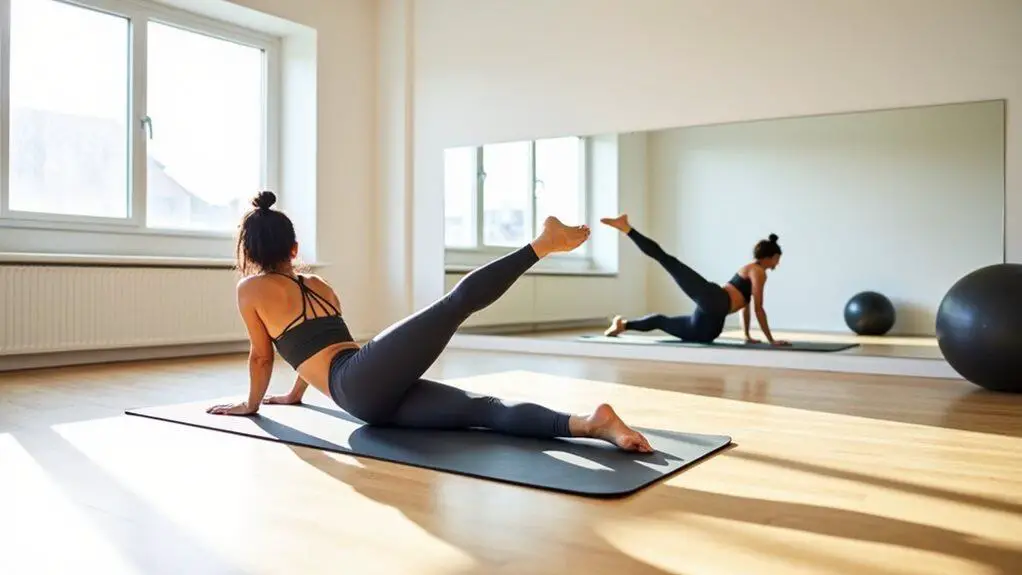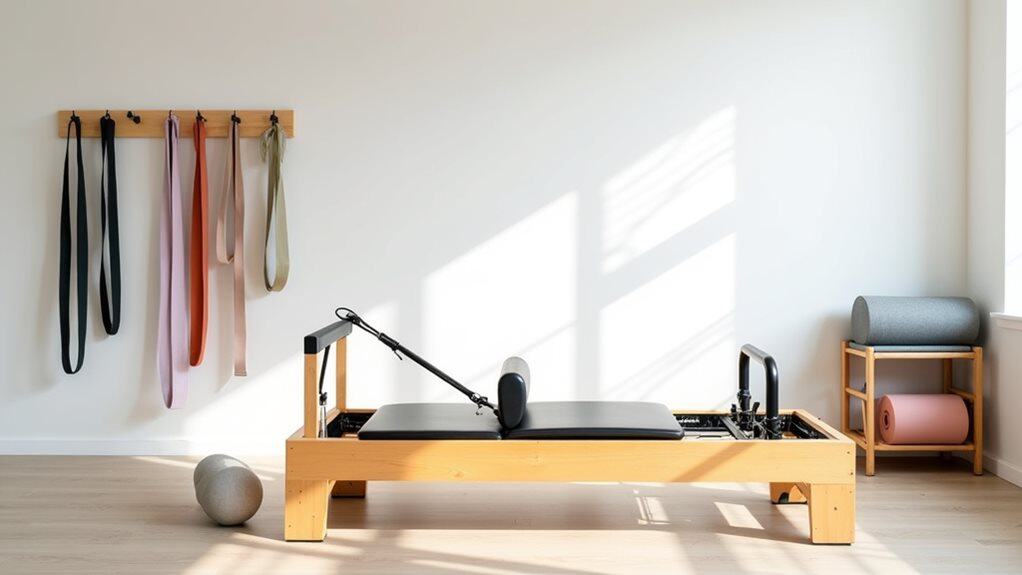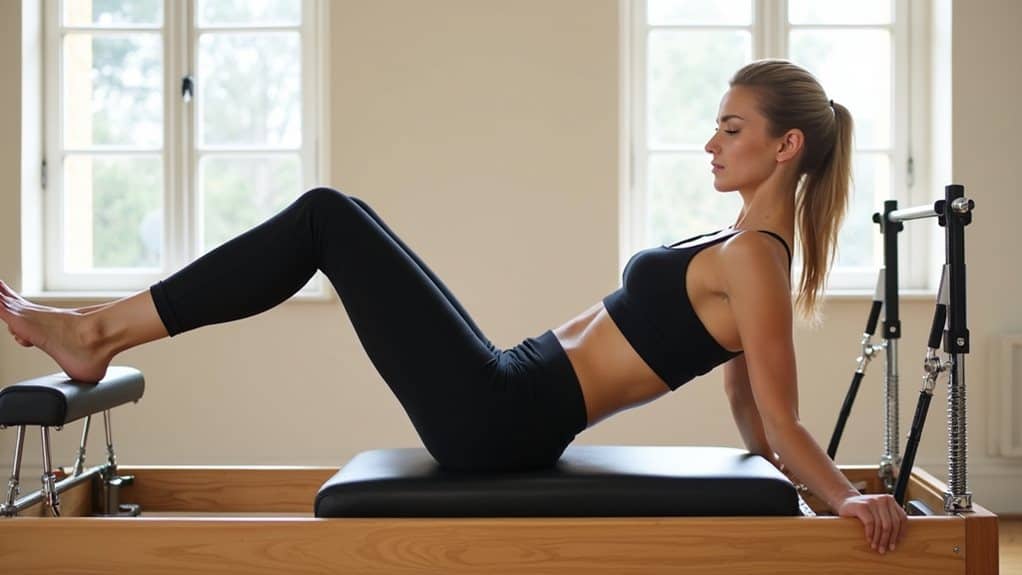Are you an athlete looking to take your performance to the next level? Look no further than the synergistic approach of Pilates and multi-athlete activities.
In this article, we will explore the numerous benefits of incorporating Pilates into your training routine. From injury prevention and rehabilitation to improved performance in specific sports, Pilates offers a wide range of advantages for athletes of all levels.
Whether you are a professional athlete or someone who enjoys participating in various sports, Pilates can help you enhance your strength, flexibility, and overall athletic performance.
We will also discuss the different Pilates equipment and props that can be used to target specific muscle groups and address sport-specific needs.
Get ready to discover how incorporating Pilates into your training can transform your athletic abilities and elevate your performance to new heights.
Benefits of Pilates for Athletes
You’ll be amazed at how Pilates can boost your athletic performance and take your game to the next level! Pilates is a highly effective form of exercise that offers numerous benefits for athletes like you.
One of the key advantages of Pilates is its ability to prevent injuries. By focusing on core strength and stability, Pilates helps improve your body’s overall alignment and balance, reducing the risk of strains, sprains, and other common athletic injuries.
Additionally, Pilates incorporates flexibility training, which is essential for athletes looking to enhance their range of motion and prevent muscle imbalances. By improving your flexibility, you’ll be able to move more freely and efficiently, which can lead to better performance and reduced risk of injury.
Incorporating Pilates into your training routine is not only practical but also evidence-based. Numerous studies have shown the positive effects of Pilates on athletic performance. For example, a study published in the Journal of Sports Science and Medicine found that Pilates training improved core strength, flexibility, and balance in soccer players. Another study in the Journal of Strength and Conditioning Research reported that Pilates increased hamstring flexibility in runners. These findings provide solid evidence that Pilates can indeed benefit athletes like you.
As we transition into the next section about injury prevention and rehabilitation, it’s important to note that Pilates is not just about preventing injuries but also aiding in recovery. The controlled movements and focus on proper alignment in Pilates can help rehabilitate and strengthen injured muscles and joints.
So, if you’re looking to enhance your athletic performance and minimize the risk of injuries, Pilates is a fantastic addition to your training regimen.
Injury Prevention and Rehabilitation
Start by incorporating a diverse range of exercises to prevent and rehabilitate injuries effectively. Pilates is an excellent form of exercise for injury prevention and rehabilitation, as it focuses on strengthening the core muscles, improving flexibility, and enhancing body awareness. By engaging in regular Pilates sessions, athletes can reduce the risk of injuries and promote faster recovery in case of an injury.
Injury prevention is crucial for athletes to maintain their performance and avoid setbacks. Pilates helps in preventing injuries by improving muscle imbalances, correcting poor posture, and enhancing overall body alignment. It also targets specific muscle groups that are commonly prone to injuries, such as the hamstrings, hip flexors, and rotator cuff muscles.
When it comes to rehabilitation, Pilates can be highly beneficial for athletes recovering from injuries. It provides a low-impact environment that allows for controlled movements and gradual progression. Pilates exercises can help athletes regain strength, stability, and mobility in a safe and effective manner. It also aids in improving proprioception, which is essential for preventing re-injury.
To further emphasize the importance of injury prevention and rehabilitation, consider the following table:
| Injury Prevention Benefits of Pilates | Rehabilitation Benefits of Pilates |
|---|---|
| Strengthens core muscles | Promotes muscle recovery |
| Improves flexibility | Restores range of motion |
| Enhances body awareness | Increases stability and balance |
By focusing on injury prevention and rehabilitation through Pilates, athletes can enhance their overall performance in specific sports. Transitioning into the next section, incorporating Pilates into your training regimen can lead to improved performance in your chosen athletic pursuits.
Improved Performance in Specific Sports
Enhancing your athletic abilities and excelling in your chosen sport can be achieved through the incorporation of Pilates into your training routine. Pilates is known for its ability to improve agility, which is essential in many sports that require quick movements and changes in direction. By practicing Pilates, you can develop better body control, balance, and coordination, which will ultimately lead to improved performance on the field or court.
In addition to physical benefits, Pilates also offers mental focus that can give you an edge in your sport. The mind-body connection that is emphasized in Pilates helps athletes to stay present and focused during training and competition. By learning to concentrate on your movements and breath, you can enhance your ability to make split-second decisions and react quickly to game situations.
Whether you’re a basketball player looking to improve your footwork or a soccer player wanting to enhance your agility, Pilates can be a valuable tool in your training arsenal. By incorporating Pilates into your cross-training routine, you can address specific weaknesses and imbalances in your body, ultimately leading to improved performance in your sport.
So, let’s dive into the next section and explore the benefits of cross-training with Pilates.
Cross-Training with Pilates
By incorporating Pilates into your training routine, you can unlock a whole new level of fitness and performance. Pilates is a fantastic form of cross-training that can improve your core strength and flexibility, which are essential for any athlete.
The core is the foundation of all movement, and a strong core can enhance your performance in any sport. Pilates exercises focus on strengthening the deep abdominal muscles, as well as the muscles in the back and pelvis. This not only improves your stability and balance but also helps prevent injury.
Flexibility training is another key component of Pilates that can benefit athletes. Pilates exercises emphasize lengthening and elongating the muscles, which can improve your range of motion and overall flexibility. This increased flexibility can translate into better performance in sports that require a wide range of motion, such as gymnastics or martial arts.
Incorporating Pilates into your training routine can provide numerous benefits, including improved core strength and flexibility. These qualities are crucial for any athlete looking to enhance their performance.
In the next section, we will explore how Pilates equipment and props can further support athletes in their training journey.
Pilates Equipment and Props for Athletes
Take your training to the next level with the incredible variety of equipment and props available to support your athletic journey. Pilates offers a range of tools that can enhance your performance and help you excel in your sport.
Here are four must-have items for athletes looking to incorporate Pilates into their training routine:
- Resistance Bands: These versatile bands provide added resistance to your exercises, helping to strengthen and tone your muscles. They are especially beneficial for runners, as they can improve hip stability and increase stride length, leading to better running efficiency.
- Stability Balls: Also known as Swiss balls, these large inflatable balls are excellent for core strengthening and balance training. They are particularly useful for swimmers, as they can enhance core stability and improve body alignment in the water.
- Pilates Reformer: This piece of equipment offers a full-body workout, targeting both large and small muscle groups. It provides resistance through a system of springs and pulleys, allowing for a wide range of exercises. The Pilates reformer is beneficial for athletes of all sports, as it improves strength, flexibility, and overall body control.
- Foam Rollers: These cylindrical tools are great for self-massage and myofascial release. Foam rolling can help alleviate muscle tightness and improve flexibility, making it ideal for both runners and swimmers.
Incorporating Pilates into your training routine is a powerful way to enhance your athletic performance. By integrating these equipment and props into your workouts, you can reap the benefits of improved strength, flexibility, and overall body control.
Incorporating Pilates into Your Training Routine
Revitalize your training routine by seamlessly integrating the transformative power of Pilates. Incorporating Pilates into your training routine can greatly improve flexibility and core strength, giving you an edge in your multi-athlete activities.
Pilates exercises focus on strengthening the deep muscles of the abdomen, back, and pelvis, which are essential for stability and balance. By targeting these key areas, you can enhance your overall performance and reduce the risk of injury.
One of the main benefits of Pilates is its ability to improve flexibility. The exercises in Pilates involve controlled and precise movements that lengthen and stretch your muscles. This increased flexibility can help you achieve a greater range of motion, allowing you to move more efficiently and effectively in your chosen sport. Whether you’re a runner, cyclist, or team athlete, improved flexibility can enhance your performance and help you reach your goals.
In addition to flexibility, Pilates also focuses on developing core strength. The core muscles, including the abdomen, back, and pelvis, are the foundation of all movement. A strong core not only improves stability and balance but also enhances power and endurance. By incorporating Pilates into your training routine, you can strengthen and stabilize your core, giving you a solid foundation for improved performance in your multi-athlete activities.
Revitalize your training routine by integrating Pilates into your workouts. Improve your flexibility and core strength, giving yourself an advantage in your multi-athlete activities. In the next section, we will explore success stories of athletes who have benefited from incorporating Pilates into their training routines.
Success Stories: Athletes Who Benefit from Pilates
Many athletes have experienced significant improvements in their performance and overall well-being after incorporating Pilates into their training routines. Pilates is not only beneficial for building strength and flexibility, but it also enhances endurance and agility.
Endurance is a key component for athletes in sports such as long-distance running, cycling, and swimming. Pilates helps improve endurance by focusing on deep core muscles, which are essential for maintaining proper posture and stability during prolonged physical activities. The controlled movements and emphasis on breathwork in Pilates also contribute to better oxygen utilization and increased stamina.
Agility is crucial for athletes participating in sports that require quick and precise movements, such as basketball, soccer, and tennis. Pilates exercises that target balance, coordination, and body awareness can enhance agility by improving neuromuscular control and reaction time. The integration of mind and body in Pilates helps athletes become more efficient in their movements, allowing them to quickly change direction, accelerate, and decelerate with ease.
By incorporating Pilates into your training routine, you can optimize your athletic performance and take it to the next level. In the next section, we will explore how Pilates can further enhance your strength, flexibility, and overall athletic abilities.
Taking Your Athletic Performance to the Next Level with Pilates
If you want to take your athletic performance to the next level, Pilates can be a game-changer for you.
Setting goals and tracking progress is essential in any training program, and Pilates is no exception.
Consistency and commitment in your Pilates practice will help you see significant improvements in your strength, flexibility, and overall performance.
The long-term benefits of Pilates go beyond the physical gains, as it can also help you integrate a healthier lifestyle into your daily routine.
Setting Goals and Tracking Progress
Start by envisioning the milestones you want to achieve and track your progress as you embark on this synergistic journey of Pilates and multi-athlete activities.
Setting goals is essential to keep yourself motivated and focused. Whether you want to improve your flexibility, strengthen your core, or enhance your overall performance, having clear objectives will guide your training. Write down your goals, both short-term and long-term, and make them specific and measurable.
Tracking your progress is equally important. Keep a journal or use a fitness app to record your workouts, track your improvements, and monitor any setbacks. This will help you see your progress over time and make adjustments as needed.
With goal setting and progress tracking, you can stay accountable and ensure that you are on the right path towards achieving your athletic aspirations.
Now, let’s delve into the next section about consistency and commitment in Pilates practice.
Consistency and Commitment in Pilates Practice
Maintaining a consistent and committed practice in Pilates is essential for building strength and flexibility. There are several reasons why consistency and commitment are important:
- Muscle Memory: Regularly practicing Pilates helps your muscles remember the movements, making them more efficient and effective over time.
- Progressive Improvement: Consistency allows you to gradually increase the intensity and difficulty of your Pilates exercises, leading to continuous progress in your strength and flexibility.
- Injury Prevention: By consistently practicing proper form and technique, you develop strong and balanced muscles, reducing the risk of injuries during other athletic activities.
- Mind-Body Connection: Committing to regular Pilates practice enhances your mind-body connection, promoting better body awareness and control.
By maintaining consistency and commitment in your Pilates practice, you will not only build strength and flexibility but also experience long-term benefits and seamlessly integrate Pilates into your lifestyle.
Long-Term Benefits and Lifestyle Integration
When you commit to integrating Pilates into your daily life, you will notice long-term benefits that enhance your overall well-being and make staying active more enjoyable.
Pilates is a versatile exercise method that improves strength, flexibility, and posture while promoting body awareness. By incorporating Pilates into your routine, you can experience improved balance, increased core strength, and enhanced muscular endurance.
These long-term benefits not only contribute to better physical health but also support mental and emotional well-being. Pilates can be easily integrated into your lifestyle, whether you are a multi-athlete or someone looking to add variety to your fitness routine.
Its low-impact nature makes it suitable for people of all ages and fitness levels. By committing to regular Pilates practice, you can achieve long-term health and fitness integration, allowing you to lead a more vibrant and fulfilling life.
Final Thought
In conclusion, incorporating Pilates into your training routine can be a game-changer for athletes. The benefits of Pilates make it a valuable addition to any athlete’s regimen. By cross-training with Pilates, you can strengthen your core, improve flexibility, and enhance overall body awareness.
Pilates is known for its ability to prevent injuries and improve performance. It focuses on strengthening the deep muscles of the core, which are essential for stability and balance. This can help athletes maintain proper form and technique, reducing the risk of injuries during training and competition.
Additionally, Pilates helps improve flexibility, which is crucial for multi-athlete activities that require a wide range of motion. By increasing flexibility, athletes can move more efficiently and with greater ease, enhancing their performance in activities such as running, swimming, and cycling.
Moreover, Pilates enhances overall body awareness, which is essential for multi-athlete activities that involve complex movements and coordination. By practicing Pilates, athletes become more attuned to their body’s alignment, posture, and movement patterns. This increased body awareness can translate into improved performance in various sports and activities.
Numerous success stories from athletes who have integrated Pilates into their training showcase its effectiveness. They report improved performance, reduced injuries, and enhanced overall athletic ability.
So, why not take your athletic performance to the next level with Pilates? Start reaping the benefits today by incorporating Pilates into your training routine.




